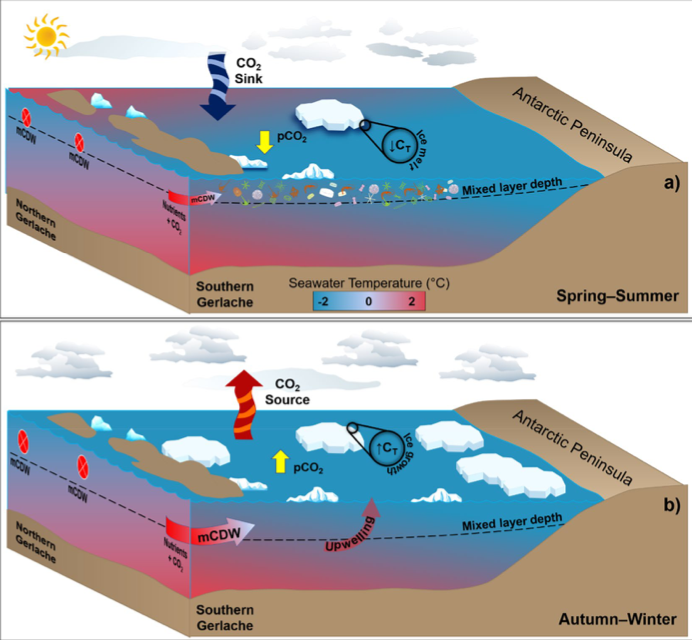• The spatial variability of the carbonate system parameters is clearly greater in spring and summer than in autumn and winter.
• The carbonate system parameters on the surface of the strait follow seasonal FCO2 dynamics, that is, sea ice dynamics.
• The effects of intensified summer CO2 uptake on calcite and aragonite saturation in surface waters may emerge in the coming years.
Seasonal variability of net sea-air CO2 fluxes in a coastal region of the northern Antarctic Peninsula
Abstract - https://doi.org/10.1038/s41598-020-71814-0
We show an annual overview of the sea-air CO2 exchanges and primary drivers in the Gerlache Strait, a hotspot for climate change that is ecologically important in the northern Antarctic Peninsula. In autumn and winter, episodic upwelling events increase the remineralized carbon in the sea surface, leading the region to act as a moderate or strong CO2 source to the atmosphere of up to 40 mmol m–2 day–1. During summer and late spring, photosynthesis decreases the CO2 partial pressure in the surface seawater, enhancing ocean CO2 uptake, which reaches values higher than − 40 mmol m–2 day–1. Thus, autumn/winter CO2 outgassing is nearly balanced by an only 4-month period of intense ocean CO2 ingassing during summer/spring. Hence, the estimated annual net sea-air CO2 flux from 2002 to 2017 was 1.24 ± 4.33 mmol m–2 day–1, opposing the common CO2 sink behaviour observed in other coastal regions around Antarctica. The main drivers of changes in the surface CO2 system in this region were total dissolved inorganic carbon and total alkalinity, revealing dominant influences of both physical and biological processes. These findings demonstrate the importance of Antarctica coastal zones as summer carbon sinks and emphasize the need to better understand local/regional seasonal sensitivity to the net CO2 flux effect on the Southern Ocean carbon cycle, especially considering the impacts caused by climate change.

Figure 8. Distinct processes driving surface CO2 partial pressure (pCO2) and seasonal sea-air CO2 fluxes in a coastal region of the northern Antarctic Peninsula (NAP). From (a) December to March, sea ice melting provides a shallow mixed layer that leads to phytoplankton growth. This spring–summer scenario coupled with less intense modified Circumpolar Deep Water (mCDW) intrusions into the NAP and a decrease in total dissolved inorganic carbon (CT) from meltwater causes pCO2 drawdown. Therefore, in these months, the region behaves as a strong sink of atmospheric CO2. Conversely, from (b) April to November, under sea ice cover conditions, more intense mCDW intrusions coupled with a deeper mixed layer lead to intensified vertical mixing, resulting in the upwelling of CO2-rich waters. Such processes, in association with the rejection of CT through brine release during sea ice growth, lead to a significant increase in surface pCO2. Then, the region becomes a moderate to strong CO2 source to the atmosphere during the autumn–winter. The theoretical depth of the shallowest spring–summer mixed layer is approximately 50 m, reaching approximately 150 m in the autumn–winter61. Drawn by Thiago Monteiro. Symbols courtesy of the Integration and Application Network, University of Maryland Center for Envrionmental Science (ian.umces.edu/symbols/).

